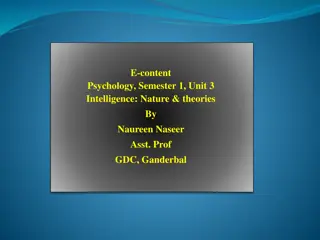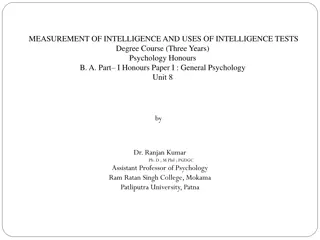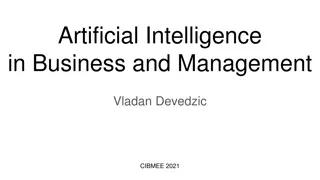Understanding Swarm Intelligence: Concepts and Applications
Swarm Intelligence (SI) is an artificial intelligence technique inspired by collective behavior in nature, where decentralized agents interact to achieve goals. Swarms are loosely structured groups of interacting agents that exhibit collective behavior. Examples include ant colonies, flocking birds, and traffic flow. SI algorithms like Ant Colony Optimization and Particle Swarm Optimization are based on these principles, offering innovative solutions to optimization problems. Biologically inspired computation, such as Ant Colony Optimization, mimics real ant behavior to solve various optimization challenges.
- Swarm Intelligence
- SI Algorithms
- Ant Colony Optimization
- Collective Behavior
- Nature-Inspired Computing
Download Presentation

Please find below an Image/Link to download the presentation.
The content on the website is provided AS IS for your information and personal use only. It may not be sold, licensed, or shared on other websites without obtaining consent from the author. Download presentation by click this link. If you encounter any issues during the download, it is possible that the publisher has removed the file from their server.
E N D
Presentation Transcript
Swarm Intelligence
Outline Background o What is a Swarm Intelligence (SI)? o Examples from nature o Origins and Inspirations of SI Ant Colony Optimization Particle Swarm Optimization
What is a Swarm? A loosely structured collection of interacting agents o Agents: Individuals that belong to a group (but are not necessarily identical) They contribute to and benefit from the group They can recognize, communicate, and/or interact with each other The instinctive perception of swarms is a group of agents in motion but that does not always have to be the case. A swarm is better understood if thought of as agents exhibiting a collective behavior
Swarm Intelligence (SI) An artificial intelligence (AI) technique based on the collective behavior in decentralized, self-organized systems Generally made up of agents who interact with each other and the environment No centralized control structures Based on group behavior found in nature
Examples of Swarms in Nature: Classic Example: Swarm of Bees Can be extended to other similar systems: o Ant colony Agents: ants o Flock of birds Agents: birds o Traffic Agents: cars o Crowd Agents: humans o Immune system Agents: cells and molecules
Two Common SI Algorithms Inspiration from swarm intelligence has led to some highly successful optimisation algorithms. o Ant Colony (-based) Optimisation a way to solve optimisation problems based on the way that ants indirectly communicate directions to each other. o Particle Swarm Optimisation a different way to solve optimisation problems, based on the swarming behaviour of several kinds of organisms.
Biologically Inspired Computation Ant Colony Optimisation
Ant Colony Optimization (ACO) The study of artificial systems modeled after the behavior of real ant colonies and are useful in solving discrete optimization problems Introduced in 1992 by Marco Dorigo o Originally called it the Ant System (AS) o Has been applied to Traveling Salesman Problem (and other shortest path problems) Several NP-hard Problems It is a population-based metaheuristic used to find approximate solutions to difficult optimization problems
Overview Ant Colony Optimization (ACO) studies artificial systems that take inspiration from the behavior of real ant colonies and which are used to solve discrete optimization problems. -Source: ACO website, http://iridia.ulb.ac.be/~mdorigo/ACO/about.html
Artificial Ants A set of software agents Stochastic Based on the pheromone model o Pheromones are used by real ants to mark paths. Ants follow these paths (i.e., trail-following behaviors) Incrementally build solutions by moving on a graph Constraints of the problem are built into the heuristics of the ants
A key concept: Stigmergy Stigmergy is: indirect communication via interaction with the environment. A problem gets solved bit by bit .. Individuals communicate with each other in the above way, affecting what each other does on the task. Individuals leave markers or messages these don t solve the problem in themselves, but they affect other individuals in a way that helps them solve the problem
Naturally Observed Ant Behavior All is well in the world of the ant.
Naturally Observed Ant Behavior Oh no! Oh no! An obstacle has blocked our path!
Naturally Observed Ant Behavior Where do we go? Everybody, flip a coin.
Naturally Observed Ant Behavior Shorter path reinforced.
Stigmergy in Ants Ants are behaviorally unsophisticated, but collectively they can perform complex tasks. Ants have highly developedsophisticatedsign- basedstigmergy o They communicate using pheromones; o They lay trails of pheromone that can be followed by other ants. If an ant has a choice of two pheromone trails to follow, one to the NW, one to the NE, but the NW one is stronger which one will it follow?
Pheromone Trails Individual ants lay pheromone trails while travelling from the nest, to the nest or possibly in both directions. The pheromone trail gradually evaporates over time. But pheromone trail strength accumulate with multiple ants using path. Food source Nest
Pheromone Trails continued Initial state: Initial state: no ants no ants E E E t = 0 t = 1 30 ants 30 ants D D D 15 ants 10 ants 15 ants 20 ants d = 1 d = 0.5 = 30 = 15 H C H C H C = 15 = 30 d = 0.5 d = 1 15 ants 20 ants 15 ants 10 ants B B B 30 ants 30 ants A A A (b) (c) (a)
Ant Colony Optimisation Algorithms: Basic Ideas Ants are agents that: Move along between nodes in a graph. They choose where to go based on pheromone strength. An ant s path represents a specific candidate solution. When an ant has finished a solution, pheromone is laid on its path, according to quality of solution. This pheromone trail affects behaviour of other ants by `stigmergy
Using ACO The optimization problem must be written in the form of a path finding problem with a weighted graph The artificial ants search for good solutions by moving on the graph o Ants can also build infeasible solutions which could be helpful in solving some optimization problems The metaheuristic is constructed using three procedures: o ConstructAntsSolutions o UpdatePheromones o DaemonActions
Construct Ants Solutions Manages the colony of ants Ants move to neighboring nodes of the graph Moves are determined by stochastic local decision policies based on pheromone trails and heuristic information Evaluates the current partial solution to determine the quantity of pheromones the ants should deposit at a given node
Update Pheromones Process for modifying the pheromone trails Modified by o Increase Ants deposit pheromones on the nodes (or the edges) o Decrease Ants don t replace the pheromones and they evaporate Increasing the pheromones increases the probability of paths being used (i.e., building the solution) Decreasing the pheromones decreases the probability of the paths being used (i.e., forgetting)
Daemon Actions Used to implement larger actions that require more than one ant Examples: o Perform a local search o Collection of global information
Applications Of ACO Vehicle routing with time window constraints Network routing problems Assembly line balancing Heating oil distribution Data mining
E.g. A 4-city TSP Initially, random levels of pheromone are scattered on the edges A B D C Pheromone AB: 10, AC: 10, AD, 30, BC, 40, CD 20 Ant
E.g. A 4-city TSP An ant is placed at a random node A B D C Pheromone AB: 10, AC: 10, AD, 30, BC, 40, CD 20 Ant
E.g. A 4-city TSP The ant decides where to go from that node, based on probabilities calculated from: - pheromone strengths, - next-hop distances. A B Suppose this one chooses BC D C Pheromone AB: 10, AC: 10, AD, 30, BC, 40, CD 20 Ant
E.g. A 4-city TSP The ant is now at C, and has a `tour memory = {B, C} so he cannot visit B or C again. Again, he decides next hop (from those allowed) based on pheromone strength and distance; suppose he chooses CD A B D C Pheromone AB: 10, AC: 10, AD, 30, BC, 40, CD 20 Ant
E.g. A 4-city TSP The ant is now at D, and has a `tour memory = {B, C, D} There is only one place he can go now: A B D C Pheromone AB: 10, AC: 10, AD, 30, BC, 40, CD 20 Ant
E.g. A 4-city TSP So, he has nearly finished his tour, having gone over the links: BC, CD, and DA. A B D C Pheromone AB: 10, AC: 10, AD, 30, BC, 40, CD 20 Ant
E.g. A 4-city TSP So, he has nearly finished his tour, having gone over the links: BC, CD, and DA. AB is added to complete the round trip. A B Now, pheromone on the tour is increased, in line with the fitness of that tour. D C Pheromone AB: 10, AC: 10, AD, 30, BC, 40, CD 20 Ant
E.g. A 4-city TSP A B Next, pheromone everywhere is decreased a little, to model decay of trail strength over time D C Pheromone AB: 10, AC: 10, AD, 30, BC, 40, CD 20 Ant
E.g. A 4-city TSP We start again, with another ant in a random position. A B Where will he go? Next , the actual algorithm and variants. D C Pheromone AB: 10, AC: 10, AD, 30, BC, 40, CD 20 Ant
The ACO algorithm for the TSP We have a TSP, with n cities. 1. We place some ants at each city. Each ant then does this: It makes a complete tour of the cities, coming back to its starting city, using a transition rule to decide which links to follow. By this rule, it chooses each next-city at random, but based partly by the pheromone levels existing at each path, and based partly by heuristic information. 2. When all ants have completed their tours. Global Pheromone Updating occurs. The current pheromone levels on all links are reduced (I.e. pheromone levels decay over time). Pheromone is laid (belatedly) by each ant as follows: it places pheromone on all links of its tour, with strength depending on how good the tour was.
The ACO algorithm for the TSP [a simplified version with all essential details] We have a TSP, with n cities. 1. We place some ants at each city. Each ant then does this: It makes a complete tour of the cities, coming back to its starting city, using a transition rule to decide which links to follow. By this rule, it chooses each next-city at random, but biased partly by the pheromone levels existing at each path, and biased partly by heuristic information. 2. When all ants have completed their tours. Global Pheromone Updating occurs. The current pheromone levels on all links are reduced (I.e. pheromone levels decay over time). Pheromone is lain (belatedly) by each ant as follows: it places pheromone on all links of its tour, with strength depending on how good the tour was. Then we go back to 1 and repeat the whole process many times, until we reach a termination criterion.
ACO Algorithm Set all parameters and initialize the pheromone trails Loop Sub-Loop Construct solutions based on the state transition rule Apply the online pheromone update rule Continue until all ants have been generated Apply Local Search Evaluate all solutions and record the best solution so far Apply the offline pheromone update rule Continue until the stopping criterion is reached
ACO System, cont. Often applied to TSP (Travelling Salesman Problem): shortest path between n nodes Algorithm in Pseudocode: o Initialize Trail o Do While (Stopping Criteria Not Satisfied) Cycle Loop Do Until (Each Ant Completes a Tour) Tour Loop Local Trail Update End Do Analyze Tours Global Trail Update o End Do 41
Ant Systems Algorithm for TSP Initialize Place each ant in a randomly chosen city For Each Ant Choose NextCity(For Each Ant) more cities to visit yes No Return to the initial cities Update pheromone level using the tour cost for each ant No Stopping criteria yes Print Best tour
Ant Colony Optimization Characteristics of the algorithm An ant is a solution. Solutions (ants) are at different places in the solution space. How they change is based on the probability of changing to a different schedule. An ant completes its tour after selection a choice for each stand. Utilities (objective function values) of each tour are calculated. Pheromone levels are updated after all of the ants have completed all of their tours.
Ant Colony Optimization Characteristics of the algorithm The probability of moving from Point A to Point B depends on the attractiveness of the move and the trail level. A Attractiveness - an a priori desirability (typically based on the inverse distance) of the move. ? Trail level - an a posteriori, computed attractiveness. This is computed after an ant completes a solution, increasing or decreasing the desirabilities of components of a solution. C B ( )( ) Amount of pheromone Desirabili ty of state transition = Prob A B A B A B ( )( ) Amounts of pheromones Desirabili ties























